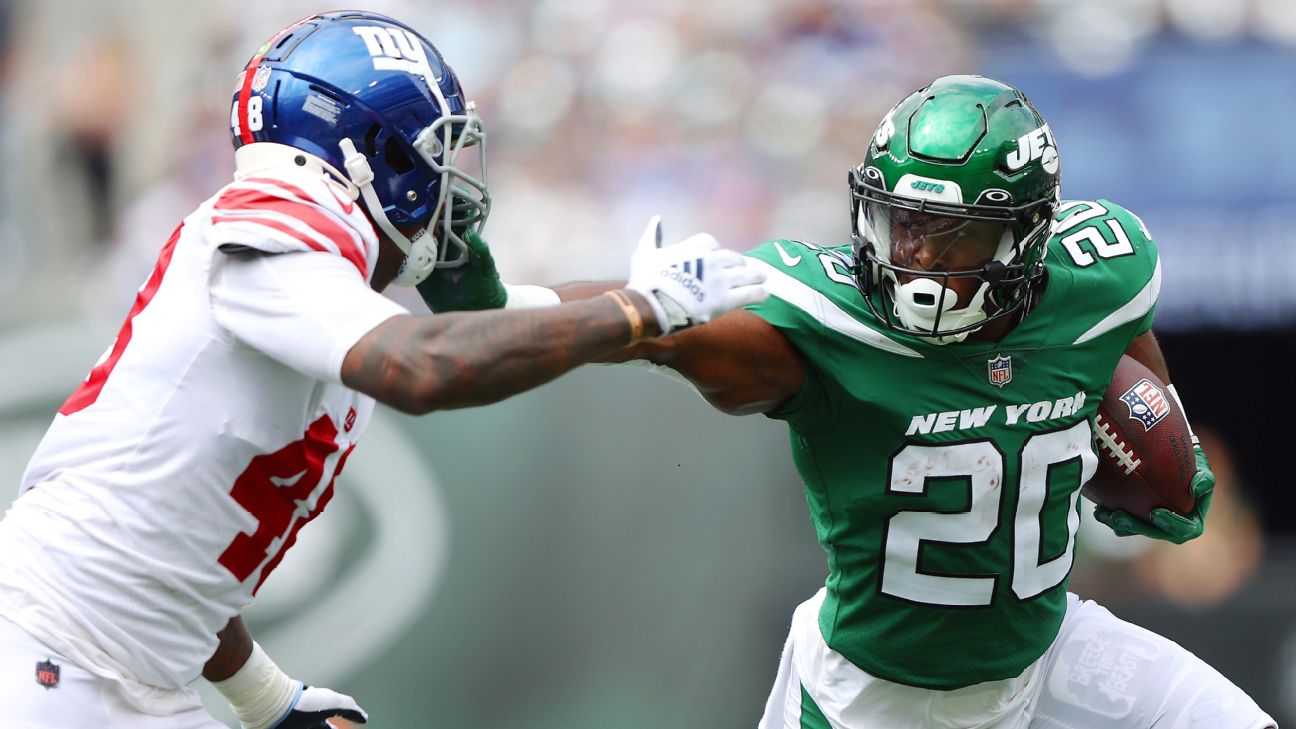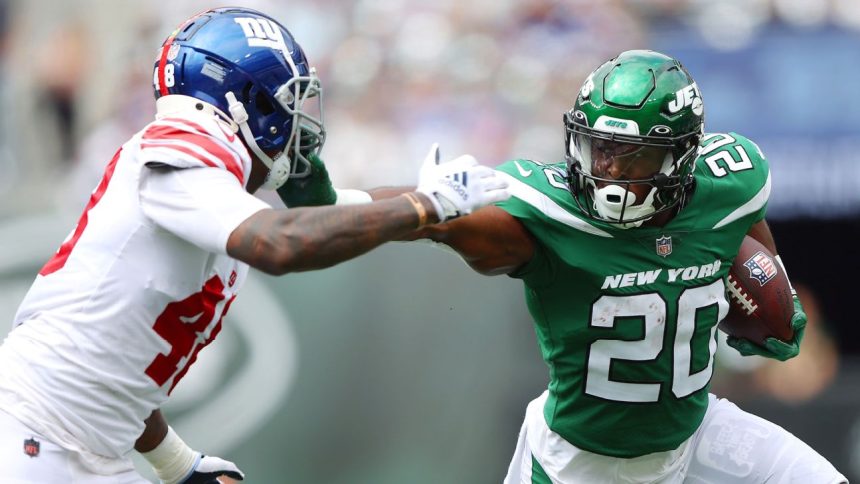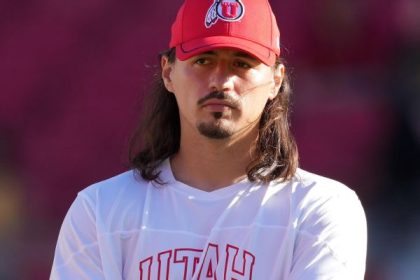
Prepping for the upcoming fantasy football season requires asking tough questions.
Which NFL teams are set up for success? Which teams are set to struggle? Where can fantasy managers mine for latent fantasy talent? Which brand-name stars could actually disappoint?
Throughout June, I’ll sift through every NFL division and highlight the most pressing fantasy question facing each team. Next up: the AFC East.
Pressing fantasy questions by division:
AFC East | AFC North | AFC South
NFC North | NFC South
Will anyone emerge from the Bills’ new-look backfield as a regular fantasy starter?
With Devin Singletary (and his 200-plus touches) gone, a regular producer is bound to materialize. And his name is James Cook. Dalvin’s little brother was second in touches to the aforementioned Singletary, with 89 rushes and 21 grabs as a rookie. Although Cook’s volume will undoubtedly surge, it probably won’t double or eclipse Singletary’s. At least not with Damien Harris joining the backfield.
Harris, who missed six regular-season contests last season to a thigh injury, is expected to work on early downs and in a short-yardage capacity. Although the 26-year-old figures to command close to 10 touches per week, he’s not the Bills’ RB1. Buffalo invested a second-round pick in Cook, making him the third RB selected in April 2022. Conversely, the team signed Harris to a low-risk, one-year deal.
Furthermore, Buffalo isn’t a run-first operation. The Bills have ranked fifth in pass rate over the past three seasons. That works out well for Cook, who shines as a pass-catcher and whose receiving talents were regularly featured at Georgia. The upside belongs to the second-year RB, who is shaping up to be a solid “dead zone” target for managers in PPR-friendly formats.
Takeaway: Cook might be unproven, but he figures to lead the backfield of a top-three offense, touching the ball 12 to 14 times per week. That makes him an RB3/flex with RB2 upside.
Is Tua Tagovailoa worth the risk of being your QB1?
Risk is an essential part of winning, and Tua presents with an elevated injury risk. He also has one of the league’s most dynamic receiving duos at his disposal. Tyreek Hill and Jaylen Waddle combined for more than 3,000 receiving yards and 15 TDs last season. Both wideouts additionally finished in the top 10 fantasy producers at their position. That production obviously benefited their QB, who averaged the 10th-most fantasy points per game among qualified starters (17.8).
But averages lack context, though. Tua played in 11 full games last season. He was a top-12 fantasy QB in six of those outings and managed four top-five efforts. On the other hand, Kirk Cousins (who is similarly ranked), recorded nine top-12 fantasy finishes but was a top-five producer only twice all season. Cousins has been durable for the length of his career and has a better offensive line, but his ceiling just isn’t as high (although it’s getting closer with the addition of Jordan Addison).
Being tempted by Tagovailoa’s upside makes loads of sense. And if current ADP is any indication, managers won’t have to reach for it, as he’s coming off draft boards in the 10th round of 12-team leagues (about a round after Cousins). There figure to be plenty of insurance policies available, especially when noting that seven QBs averaged between 15.0 and 16.7 fantasy points per game last season.
Takeaway: Tua’s perceived risk is baked into his later-round ADP, making him an intriguing value target for managers wanting to lean into his upside. Relying on the 25-year-old for QB1 fantasy production, however, requires drafting a higher-end backup such as Aaron Rodgers to even out potential volatility.
�� Fantasy Debate ��
*IF* you were interested in waiting on QB in redraft… which later round pick (all with similar ADPs) are you targeting? #fantasyfootball
– Liz Loza (@LizLoza_FF) June 16, 2023
Will Rhamondre Stevenson be a dependable RB1 this season?
The “never draft a Patriots running back” trope was clever … five years ago. New England’s backfield has become more focused of late. Damien Harris was a top-10 fantasy producer as recently as 2021. Stevenson, who flashed as a rookie while Harris was cruising and then took control of the backfield in his sophomore campaign, was the RB13 overall in 2022. In fact, he became the first back in New England history to clear 200 totes and 50 grabs in a single season, recording 279 total touches in all.
Injuries to Harris and Ty Montgomery certainly increased Stevenson’s usage. With Harris no longer on the squad, however, Stevenson’s rushing attempts should remain robust. Even if Bill O’Brien gets creative with some of the pass-catchers and Montgomery manages to stay healthy, Stevenson will still draw close to five looks per week like he did a year ago. Interestingly, RBs who averaged 12.0 carries and 4.5 targets per contest (Austin Ekeler, Christian McCaffrey, Saquon Barkley, Joe Mixon and Alvin Kamara) all finished inside the top 13 fantasy producers at the position last season.
Takeaway: Coming off an impressive second-year effort and with little talent behind him, Stevenson figures to touch the ball 16 to 18 times per week, making him a low-end RB1 for fantasy purposes.
Is it reasonable to expect RB1 production from Breece Hall coming back from injury?
No. At least not until Halloween.
Hall had a solid start to his rookie season in 2022, managing two top-25 fantasy finishes in his first three games. And by early October, the Iowa State product was rolling. He averaged more than 20 touches per game, racked up nearly 400 scrimmage yards and found the end zone three times from Weeks 4 through 6. A torn ACL in Week 7, however, derailed his RB1 ascent.
Although the 22-year-old’s rehab has remained on track and the team is optimistic he’ll suit up for the season opener, it’s important for fantasy managers to temper their expectations. A player’s return to sport is different from a player’s return to target level of performance. In an effort to avoid reinjury, Hall is likely to be eased back into the offense. And with early-season matchups against the Bills, Chiefs and Eagles, his opportunities, as well as his efficiency, might falter.
Takeaway: Hall figures to work his way back to a robust workload, eventually handling the ball 18 to 20 times per contest. But his volume and subsequent production probably won’t peak until after the Jets’ Week 7 bye.
Follow Liz on Twitter: @LizLoza_FF











